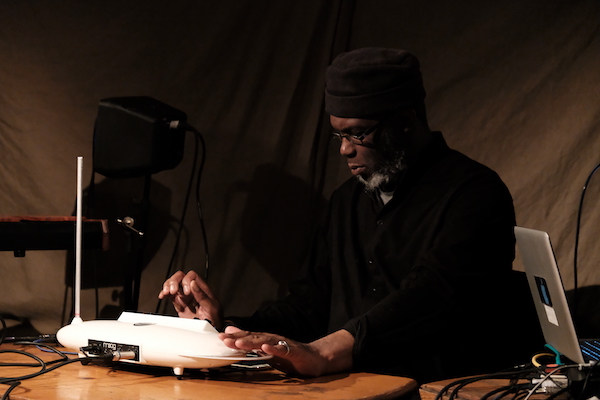Apr 2, 2024 12:59 PM
Saxophonist, Sonic Explorer Casey Benjamin Dies at 45
Casey Benjamin, the alto saxophonist, vocalist, keyboardist and producer who stamped his distinctive sounds on the…

Pianist Pat Thomas recently has enjoyed some serious momentum.
(Photo: Cristina Marx)Keyboardist and improviser Pat Thomas, 59, has been a prolific polymath on the U.K. jazz and improv scene for four decades, working in a dizzying array of projects and styles. Yet, he remains an overlooked figure in much of the world, especially in the States, where he’s never had the chance to perform.
Even in his homeland, Thomas often has been taken for granted, although that began to change in 2014 when he received one of the prestigious Paul Hamlyn Foundation Awards for Artists—an annual U.K. honor akin, albeit more financially modest, to a MacArthur Fellowship.
In 2019, however, Thomas enjoyed some serious momentum, unleashing a barrage of excellent recordings—from the ruminative post-bop piano trio heard on BleySchool, the free improv of the collective trio Shifa, an exploratory trio with reedist John Butcher and drummer Ståle Liavik Solberg on Fictional Souvenirs and a stunning live solo piano set of Duke Ellington music available digitally from London’s Café Oto. The Truth, a duo recording with alto saxophonist Matana Roberts, is due out this spring from Oto’s imprint, Otoruko.
Yet the project that just might galvanize the most interest in his work is Super Majnoon (East Meets West) (Otoruko), the dazzling second album by the quartet Ahmed, which salutes the fascinating marriage of jazz and Arabic music pioneered by the bassist and oud player Ahmed Abdul-Malik. Along with alto saxophonist Seymour Wright, bassist Joel Grip and drummer Antonin Gerbal, Thomas reduces Abdul-Malik’s themes into fiercely rhythmic kernels and then rides them into infinity with a relentless churn of constantly shifting grooves.
The foursome’s first-ever performance was released as New Jazz Imagination (Umlaut) in 2017, capturing an extended, hard-driving interpretation of Abdul-Malik’s “Anxious.” The recordings on the new album were made at Hong Kong’s Empty Gallery and Café Oto in 2018, and represent a quantum leap in terms of focus and intensity.
“The first record is really great, but we were still searching,” said Thomas. “On this one, we felt like we started to create a sound for Ahmed.
“We had to find a context for playing Abdul-Malik’s music, and I think that’s how we found this collective way of playing. If we were just freely improvising, it would be very different music. The compositions are the bedrock, the foundation for what we’re doing. We wanted to do his music, but we also wanted to put our own mark on it, so we came up with this approach. We’re all coming from the improvised thing while respecting the fact that there’s this compositional framework, and we’ve used the rhythmic concepts more.”
On first glance, the music strays from its roots, but there’s an undeniable connection in its trance-like intensity. Thomas and Wright dig deep into terse, cycling phrases over the shape-shifting propulsion of Grip and Gerbal, each steadily chipping away at the theme through fine-tuned rhythmic alterations.
“Even though you might hear the repetition, it’s not like systems music where everyone is doing the same thing,” Thomas explained. “That’s why people don’t get bored with it—we’re using this traditional free improvisation and jazz approach, shifting around the rhythms, so even though the material might be static, it doesn’t get boring because the rhythm section is never doing the same thing.”
This summer the quartet has planned collaborative performances in Europe with Morocco’s Master Musicians of Jajouka, whose current leader, Bechir Attar, inspired part of the album title when he used the Arabic slang “majnoon”—or crazy—to describe the musicians. DB

Benjamin possessed a fluid, round sound on the alto saxophone, and he was often most recognizable by the layers of electronic effects that he put onto the instrument.
Apr 2, 2024 12:59 PM
Casey Benjamin, the alto saxophonist, vocalist, keyboardist and producer who stamped his distinctive sounds on the…

“He’s constructing intelligent musical sentences that connect seamlessly, which is the most important part of linear playing,” Charles McPherson said of alto saxophonist Sonny Red.
Feb 27, 2024 1:40 PM
“I might not have felt this way 30 to 40 years ago, but I’ve reached a point where I can hear value in what people…

Albert “Tootie” Heath (1935–2024) followed in the tradition of drummer Kenny Clarke, his idol.
Apr 5, 2024 10:28 AM
Albert “Tootie” Heath, a drummer of impeccable taste and time who was the youngest of three jazz-legend brothers…

“Both of us are quite grounded in the craft, the tradition and the harmonic sense,” Rosenwinkel said of his experience playing with Allen. “Yet I felt we shared something mystical as well.”
Mar 12, 2024 11:42 AM
“There are a few musicians you hear where, as somebody once said, the molecules in the room change. Geri was one of…

Henry Threadgill performs with Zooid at Big Ears in Knoxville, Tennessee.
Apr 9, 2024 11:30 AM
Big Ears, the annual four-day music celebration that first took place in 2009 in Knoxville, Tennessee, could well be…